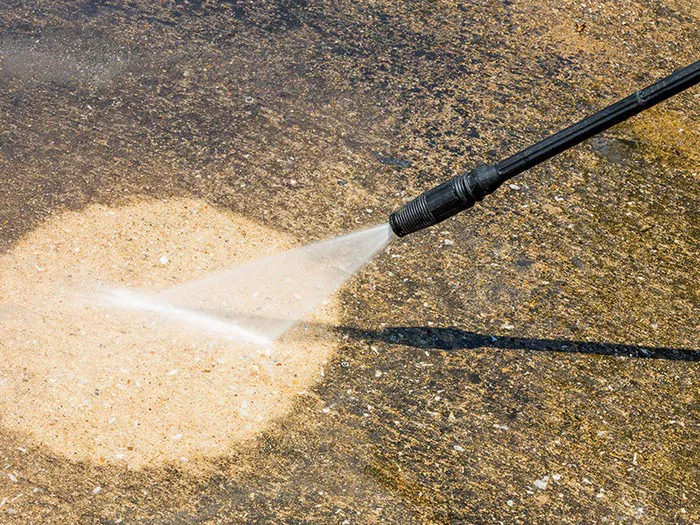Many underestimate the importance of a pressure washer nozzle. It’s the unsung hero, transforming a powerful stream of water into a targeted cleaning tool. Selecting the right nozzle unlocks the true potential of your pressure washer, allowing you to tackle various cleaning tasks with precision and efficiency. This guide delves into the world of pressure washer nozzles, empowering you to choose the perfect one for your needs.
Understanding Nozzle Spray Patterns
Nozzle spray patterns are defined by the spray angle – the angle at which water exits the nozzle. Lower angles (e.g., 0-degree) concentrate the water flow into a powerful, narrow stream. Conversely, higher angles (e.g., 40-degree) create a wider, fan-like spray.
See also: Safe Pressure Washing Your Car
Imagine a pizza. A 0-degree nozzle focuses the water pressure like a single slice, ideal for pinpoint cleaning. A 25-degree nozzle resembles two slices, offering a good balance between cleaning power and coverage. Finally, a 40-degree nozzle is like a wide wedge, providing a gentle, broad spray for rinsing.
Common Nozzle Types and Their Applications
Pressure washer nozzles often come in color-coded options for easy identification. Here’s a breakdown of popular nozzle types and their cleaning applications:
| Nozzle Color | Spray Angle | Cleaning Task | Recommended Surface |
|---|---|---|---|
| Red | 0-degree | Removing tough grime, paint, or rust | Concrete, brick, stone (use with caution) |
| Yellow | 15-degree | Powerful cleaning for surface preparation | Concrete, brick, stone, metal (use with caution on painted surfaces) |
| Green | 25-degree | Versatile cleaning for dirt, mud, and loose debris | Decks, siding, vehicles (avoid direct spray on windows) |
| White | 40-degree | Rinsing soap, light cleaning | Vehicles, windows, siding |
| Black | Low-pressure | Applying detergent | All surfaces |
Specialty Nozzles
Beyond the basic nozzles, there are specialized options for tackling unique cleaning challenges:
1. Rotating Nozzle: This nozzle combines the power of a 0-degree nozzle with a rotating head, creating a powerful cleaning action ideal for stubborn stains on concrete or stone surfaces.
2. Long-Range Detergent Nozzle: This nozzle allows for applying cleaning solution from a safe distance, perfect for cleaning gutters or second-story siding.
Choosing the Right Nozzle for Your Project
The perfect nozzle selection hinges on three key factors:
1. Cleaning Task: Consider the specific cleaning challenge. Removing paint requires a more powerful nozzle than rinsing soap.
2. Surface Material: Delicate surfaces like painted wood or vinyl siding necessitate a gentler spray pattern to avoid damage.
3. Pressure Washer PSI: Higher PSI machines can handle more aggressive nozzles, while lower PSI models might struggle with high-degree options.
See also: How Much PSI Do I Need to Pressure Wash Concrete?
Here’s a handy decision-making table to guide your nozzle selection:
| Cleaning Task | Surface Material | Pressure Washer PSI | Recommended Nozzle |
|---|---|---|---|
| Removing tough grime | Concrete | Over 2500 PSI | Red (0-degree) |
| Stripping paint | Brick | 2000-2500 PSI | Yellow (15-degree) |
| Cleaning patio furniture | Wood | 1500-2000 PSI | Green (25-degree) |
| Washing car | Painted metal | 1000-1500 PSI | White (40-degree) |
| Applying soap | Any | Any PSI | Black (detergent) |
Safety Tips for Using Pressure Washer Nozzles
Always prioritize safety when pressure washing. Here are some reminders:
1. Wear protective gear, including eye protection, gloves, and long pants.
2. Never point the nozzle at yourself or others.
3. Be mindful of the spray pattern and adjust the nozzle accordingly.
4. Avoid using high-pressure nozzles on delicate surfaces.
Conclusion
Choosing the right pressure washer nozzle empowers you to tackle cleaning tasks with precision and efficiency. By understanding spray patterns, nozzle types, and considering your specific project needs, you can unlock the full potential of your pressure washer. Remember, safety remains paramount – always prioritize appropriate gear and nozzle selection for a safe and successful cleaning experience. If you’re unsure about a specific nozzle or application, consult your pressure washer manual for detailed recommendations. Happy pressure washing!

